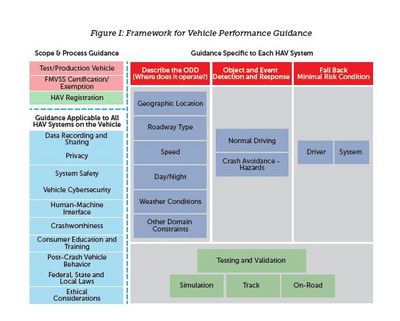
DOT's AUtomated Vehicle Performance Guidance |
[ ITS/CASE&MaaS ITS海外情報 ] 2016年9月21日 |
Overview:

Figure I provides the framework for DOT's Vehicle Performance Guidance.

It is the manufacturer or other entity's responsibility to determine their system's AV level in conformity with SAE International's published definitions. (NHTSA will review
manufacturers' automation level designations and advise the manufacturer if the
Agency disagrees with the level assigned by the manufacturer.) The figure identifies
the key areas to be addressed by manufacturers and other entities prior to testing or
deploying the vehicle on public roadways.
The framework applies to both test and production vehicles. It applies to both automated
systems' original equipment, and to replacement equipment or updates (including
software updates/upgrades) to automated systems. It includes areas that are crosscutting
(i.e., areas that apply to all automation functions on the vehicle), as well as areas
that apply to each specific automation function on the vehicle. Cross-cutting areas
include: data recording and sharing, privacy, system safety, cybersecurity, Human-
Machine Interface (HMI), crashworthiness, and consumer education and training. Areas
that are specific to each vehicle automation function are: description of the Operational
Design Domain (ODD), Object and Event Detection and Response (OEDR), and fall back
minimum risk condition.
To apply the Guidance framework, a manufacturer or other entity should start by
ensuring certification to all applicable FMVSS standards or, if needed, request an
interpretation or exemption from NHTSA. Section III of this Policy, NHTSA's Current
Regulatory Tools, provides more information on interpretations and exemptions. The
manufacturer or other entity should then follow existing DOT identification/registration
requirements (described in 49 CFR Parts 566 and 567).
For all HAV systems, the manufacturer or other entity should address the cross-cutting
items as a vehicle or equipment is designed and developed to ensure that the vehicle has
data recording and sharing capabilities; that it has applied appropriate functional safety
and cybersecurity best practices; that HMI design best practices have been followed; that
appropriate crashworthiness/occupant protection has been designed into the vehicle;
and that consumer education and training have been addressed.
In addition to the cross-cutting items, for each specific HAV system, the manufacturer or
other entity should clearly define the ODD and the corresponding SAE level to which
this system maps. The ODD, which may vary for each HAV system, will define the
conditions in which that function is intended to operate with respect to roadway types,
geographical location, speed range, lighting conditions for operation (day and/or night),
weather conditions, and other operational domain constraints. A well-defined ODD is
necessary to determine what OEDR capabilities are required for the HAV to safely operate
within the intended domain. OEDR requirements are derived from an evaluation of
normal driving scenarios, expected hazards (e.g., other vehicles, pedestrians), and
unspecified events (e.g., emergency vehicles, temporary construction zones) that could
occur within the operational domain.
(https://www.transportation.gov/AV)







